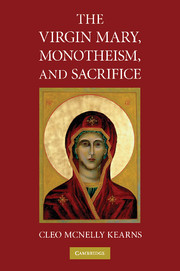Book contents
- Frontmatter
- Contents
- Preface
- Acknowledgments
- Introduction: A Vehement Flame
- PART ONE THEORIES OF SACRIFICE
- PART TWO MARY, MOTHERHOOD, AND SACRIFICE IN THE GOSPELS
- 4 Daughter of Zion: Mary in Matthew and Mark
- 5 The New Abraham: Mary in Luke
- 6 The Sorrowful Mother: Mary in John
- PART THREE MARY AND PRIESTHOOD
- Conclusion: Beyond Orthodoxy
- Notes
- Index
4 - Daughter of Zion: Mary in Matthew and Mark
Published online by Cambridge University Press: 27 July 2009
- Frontmatter
- Contents
- Preface
- Acknowledgments
- Introduction: A Vehement Flame
- PART ONE THEORIES OF SACRIFICE
- PART TWO MARY, MOTHERHOOD, AND SACRIFICE IN THE GOSPELS
- 4 Daughter of Zion: Mary in Matthew and Mark
- 5 The New Abraham: Mary in Luke
- 6 The Sorrowful Mother: Mary in John
- PART THREE MARY AND PRIESTHOOD
- Conclusion: Beyond Orthodoxy
- Notes
- Index
Summary
Serene is the night on which shines forth the Serene One Who came to give us serenity.
Do not allow anything that might disturb it to enter upon our watch.
Let the path of the ear be cleared; let the sight of the eye be chastened;
Let the contemplation of the heart be sanctified; let the speech of the mouth be purified.
Mary today has hidden in us the leaven from the house of Abraham;
Let us, therefore, love the poor as Abraham [loved] the needy.
Today she has cast rennet into use from the house of David, the compassionate one;
Let man have mercy on his persecutor as the son of Jesse on Saul.
The sweet salt of the prophets today is scattered among the peoples;
Let us acquire by it a new taste by which the former people would lose its flavor.
On this day of redemption, let us speak a speech of interpretation.
Ephrem the SyrianMay the Lord make the woman who is coming into your house like Rachel and Leah, who together built up the house of Israel.
Ruth 4As we have begun to see, the new testament stories of the annunciation to Mary and of the her role in the subsequent death and resurrection of her son are full of parallels to the accounts of mothers, fathers, and sacrificial sons in the Hebrew Bible and the Qur'an, and they are structured around many of the same concerns for the perpetuation and renewal of the lineage of Israel and its religious and cultural legacy and for the opportunities and challenges presented by motherhood, fatherhood and the problem of rival siblings in its regard.
- Type
- Chapter
- Information
- The Virgin Mary, Monotheism and Sacrifice , pp. 115 - 136Publisher: Cambridge University PressPrint publication year: 2008



